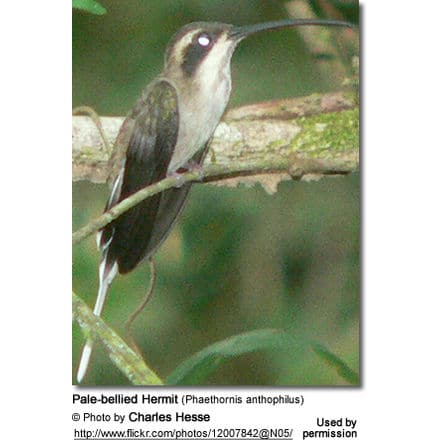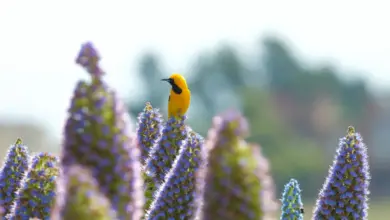Pale-bellied Hermits (Phaethornis anthophilus)
The Pale-bellied Hermits (Phaethornis anthophilus) – also known as Black-cheeked Hermit – is a South American hummingbird found in Colombia, Panama, and Venezuela.
Alternate (Global) Names
Spanish: Ermitaño Carinegro, Ermitaño de Cara Negra, Ermitaño Ventrepálido, Ermitaño Ventripálido … French: Ermite anthophile, Ermite oreillard … Italian: Colibrì del sole beccochiaro, Eremita panciachiara … German: Fahlbaucheremit, Fahlbauch-Eremit, Fleckenkehl-Schattenkolibri … Czech: Kolibrík plavobrichý, kolib?ík sv?tleb?ichý … Danish: Lysbuget Eremit … Finnish: Vaaleaerakkokolibri … Japanese: shiroharayumihachidori … Dutch: Bleke Heremietkolibrie … Norwegian: Lysbukeremitt … Polish: pustelnik jasnobrzuchy … Russian: ???????????? ????????? ??????? … Slovak: slnecnícek svetlobruchý … Swedish: Ljusbukad eremit
Subspecies and Distribution:
- Phaethornis anthophilus anthophilus (Bourcier, 1843) – Nominate Race
- Central Panama to Colombia (Magdalena Valley and east of the Andes) and northern Venezuela
- Note: Those found in the east Andes of Colombia have smaller wings and beak than other populations and may be separated as subspecies fuscicapillus
- Phaethornis anthophilus hyalinus (Bangs, 1901)
- Pearl Islands (a group of islands off the Pacific coast of Panama in the Gulf of Panama
Phaethornis anthophilus fuliginosus / Phaethornis fuliginosus (Cory, 1918)- known from the type specimen from “Bogotá” and treated as a valid species by Cory (1918), was considered a subspecies of P. anthophilus by Peters (1945). It is now considered to be a melanistic individual of an uncertain species of Phaethornis (Hinkelmann 1999).
Description
The Pale-bellied Hermits has a long, almost straight bill. The upper bill is dark colored and the lower one is orangey.
The upper plumage is green / brownish. It was named for its pale under plumage. It has a few elongated central feathers. The tail feathers are dark with white tips.
Similar Species: It somewhat resembles the Scale-throated Hermit (Phaethornis eurynome).


Nesting / Breeding
Hummingbirds in general are solitary and neither live nor migrate in flocks; and there is no pair bond for this species – the male’s only involvement in the reproductive process is the actual mating with the female.
During the breeding season, the males of many Hermit species form leks (= competitive mating displays) and congregate on traditional display grounds. Once a female enters their territory, they display for her. Their display may entail wiggling of their tails and singing.
Willing females will enter the area for the purpose of choosing a male for mating. Oftentimes she will choose the best singer.
He will separate from the female immediately after copulation. One male may mate with several females. In all likelihood, the female will also mate with several males. The males do not participate in choosing the nest location, building the nest or raising the chicks.

Diet / Feeding
The Pale-bellied Hermit primarily feed on nectar taken from a variety of brightly colored, scented small flowers of trees, herbs, shrubs and epiphytes. They favor flowers with the highest sugar content (often red-colored and tubular-shaped).
Hummingbird Resources
- Hummingbird Information
- Hummingbird Amazing Facts
- Attracting Hummingbirds to Your Garden
- Hummingbird Species
- Feeding Hummingbirds



